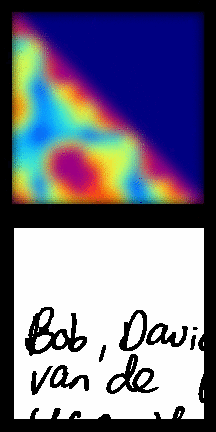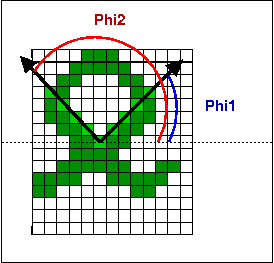
The hinge transform is a compact and understandable image feature which captures both the writing angle and trace curvature of handwriting. Since slant and roundness are very basic parameters of the writing process that are the result of both biomechanics (relative wrist/finger movement control) and allographic choice (the learned and preferred letter shapes), the hinge transform can well be used to identify and verify writers. The transform was conceived by Marius Bulacu, on the basis of earlier work by Frans Maarse, under supervision of Lambert Schomaker. It provides an excellent performance for writer identification without any training algorithm. If combined with other features, such as histograms of allographic shape usage and/or horizontal run-length histograms, the overall system will provide a comprehensive view on writing aspects, with a consequently high writer-identification rate.
The transform consists of a histogram p(phi1,phi2) where the angles phi1 and phi2 are the angles with respect to the horizontal, of the two arms of a hinged kernel that is convolved over the edges of a handwritten image. Alternatively, and much faster, the hinge can be slid along the contour of each connected ink component of writing.

Relevant papers:
- Bulacu, M. & Schomaker, L.R.B. (2007). Text-independent Writer Identification and Verification Using Textural and Allographic Features, IEEE Trans. on Pattern Analysis and Machine Intelligence (PAMI), Special Issue - Biometrics: Progress and Directions, April, 29(4), p. 701-717.
- Schomaker, L.R.B. & Bulacu, M. (2004). Automatic writer identification using connected-component contours and edge-based features of upper-case Western script. IEEE Transactions on Pattern Analysis and Machine Intelligence, Vol 26(6), June 2004, pp. 787 - 798.
- Bulacu, M. & Schomaker, L.R.B. (2003). Writer Style from Oriented Edge Fragments. In: N. Petkov & M.A. Westenberg (Eds.), LNCS 2756 - Computer Analysis of Images and Patterns, pp. 460-469.